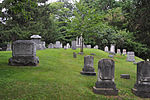Scottsville Free Library
Buildings and structures in Monroe County, New YorkEducation in Monroe County, New YorkLibraries on the National Register of Historic Places in New York (state)Library buildings completed in 1892National Register of Historic Places in Monroe County, New York ... and 2 more
Public libraries in New York (state)Queen Anne architecture in New York (state)

The Scottsville Free Library, located at 28 Main Street in the village of Scottsville, New York, with a small branch at 883 George Street in Mumford, serves the people of the towns of Wheatland and Chili, as well as adjacent areas in Monroe County. Unlike most public libraries, the Scottsville Free Library has always been a private non-profit association. Membership in this association is open to all local residents: one need merely apply for a library card. A board of seven trustees, elected by the association members to three-year terms, provides governance of the association.
Excerpt from the Wikipedia article Scottsville Free Library (License: CC BY-SA 3.0, Authors, Images).Scottsville Free Library
Main Street, Town of Wheatland
Geographical coordinates (GPS) Address Nearby Places Show on map
Geographical coordinates (GPS)
| Latitude | Longitude |
|---|---|
| N 43.019722222222 ° | E -77.750277777778 ° |
Address
Main Street 32
14546 Town of Wheatland
New York, United States
Open on Google Maps











